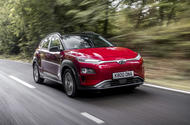Car makers are beginning to see the advantages of smaller packs
Early electric cars were defined by range. While range remains an important part of an EV’s spec panel, a broader understanding of battery sizes and efficiency, as well as the reliability of the charging network and the speed at which an EV can be recharged have become just as prominent and important as that ultimate range figure.
Unless a car’s range is notably smaller compared to the market norm or notably greater, then it can be 234 miles, 256 miles or 291 miles and that can typically be defined as being somewhere between enough and more than enough. EV drivers have realised running out of charge is ultimately as likely as running out of fuel in a petrol car, even if it’s a more complex situation to be able to avoid.
Yet overall range is fast making a comeback as the biggest number in town due to the relationship it has with the car’s price. Executives from Mazda, Toyota, Polestar and Nissan have all recently dropped not-too-subtle hints in interviews with Autocar Business that the fastest way to reduce the cost of electric cars – which are proving prohibitively expensive to be able to crack past the early adopters and incentivised fleet buyers – is to reduce the size of the battery and thus the range, while speeding up charging at the same time.
Lexus’s design boss Simon Humphries put it bluntly when he said: “Costs can come down if the acceptance of range comes down. Customers can decide.” When the battery is widely accepted to be anything from 40-60% of the cost of a car, you can see why.
There is a related argument that by using smaller batteries you will ultimately use fewer natural resources, too. This is why Toyota so passionately still pushes forward hybrids with small batteries for real-world efficiency, yet the same can be said for EVs.
Mazda’s chief financial officer Jeff Guyton was quoted in this column earlier this year: “From a consumer standpoint, people often think that bigger is better, right? The MX-30 [Mazda’s first EV], I think, offers people a usable daily driving range. Doesn’t it make sense that if you have a 30-something kWh battery instead of a 100kWh battery, then three people can have those precious resources that are in that battery?”
Polestar boss Thomas Ingenlath believes it’s faster charging that can ultimately bring down battery sizes and therefore costs. His firm has invested in a company called StoreDot, which has developed extreme fast charging using existing battery technology and architectures that can achieve 100 miles of range in five minutes
“It will allow you to reduce the resources you put into the car,” he says on faster charging times. “From a material perspective and from the customer’s money you put into a car, it’s much better to find the efficiency with fast charging and higher efficiency of a car. If you go towards smaller batteries, everything benefits, including the weight.”
All of which begs the question: how much range is necessary? For now, a larger range nearly always means a larger battery and thus a much larger cost.
The likes of Lucid, BMW and Mercedes have all broken through the 100kWh barrier with premium electric models that cost more than £100,000. Yet the fact that jumbo battery packs are now being offered in 4.5-metre-long crossovers with the likes of the Peugeot e-3008 soon to offer a near-100kWh battery shows that range is still considered the ultimate selling point for EVs. Given the standard e-3008 with a 73kWh battery costs almost £50,000, the price of the larger 98kWh one and its 435-mile range that will follow at the end of next year will be eye-watering.
Nissan’s Cli Lyons, vice president for product and services planning across Nissan’s AMIEO region, which includes Europe, says her firm thinks differently when it comes to range.
“Customers think of destinations: journey lengths and journey times,” she told me. “For us, range is the reality of driving distance and the total journey time. If you have a bigger battery, you stop less and then take longer to charge. If you have a smaller battery, you stop more but charge for less time. It’s then different by segment, but you need to understand customer needs and usage.
“You should never ask customers to change habits, instead offer solutions that fit into their lifestyle. We’d never say we want to have, say, a 110kWh battery, we’d say to do this journey in this time, and then be competitive with rivals.”
Ultimately, there’s a direct link between charging infrastructure and battery size and therefore vehicle cost that won’t be uncoupled until the former is truly fit for purpose. Batteries have been made bigger to compensate for a lack of charging infrastructure and consumer confidence in charging is lagging and will take time to shift.
“At some point, customers will feel comfortable with range as the network will be able to support them,” says Shunsuke Shigemoto, Nissan’s vice president ePowertrain technology, research and advanced engineering, with ultimately confidence in charging allowing for an acceptance of smaller range and the healthy by-product of less cost.
“Customers will go on this journey with OEMs and society, but it’s not going to take us to a 200kWh battery.”







